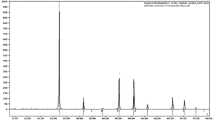Abstract
Scandium is a critical component for high strength aluminum products, yet manufacture is burdened by challenges in metal reduction and alloying. Current best practice begins with generation of an aluminum-scandium master alloy from oxide or halide precursors. However, this approach is characterized by high costs and large environmental impacts. Recent results have shown that employing a metal sulfide feedstock for aluminum master alloy production increases metal yield and improves process economics. Herein, we conduct the sulfidation of scandium oxide using elemental sulfur to generate a scandium sulfide intermediate, which we experimentally confirm to be amenable for reduction to metal. We demonstrate production of aluminum-scandium master alloy at the hundred-gram scale from scandium sulfide using aluminothermic reduction via reactive vacuum distillation. Chemical analysis is conducted to determine product purity and yield. Operating conditions to manufacture master alloys with scandium contents of 2 wt% and higher are tested.
Access this chapter
Tax calculation will be finalised at checkout
Purchases are for personal use only
Similar content being viewed by others
References
Ahmad Z (2003) The Properties and Application of Scandium-Reinforced Aluminum. J. Miner. Met. Mater. Soc. 55:35–39
Riva S, Yusenko K V., Lavery N P, Jarvis D J, & Brown S G R (2016) The scandium effect in multicomponent alloys. Int. Mater. Rev. 61(3):203–228. https://doi.org/10.1080/09506608.2015.1137692
Botelho Junior A B, Espinosa D C R, Vaughan J, & Tenório J A S (2021) Recovery of scandium from various sources: A critical review of the state of the art and future prospects. Miner. Eng. 172:107148. https://doi.org/10.1016/j.mineng.2021.107148
Zhang L, Zhang T A, Lv G, Zhang W, Li T, & Cao X (2021) Separation and Extraction of Scandium from Titanium Dioxide Waste Acid. JOM 73(5):1301–1309. https://doi.org/10.1007/s11837-021-04629-7
Kaya Ş, Dittrich C, Stopic S, & Friedrich B (2017) Concentration and separation of scandium from Ni laterite ore processing streams. Metals (Basel). 7(12):0–6. https://doi.org/10.3390/met7120557
Wang W, Pranolo Y, & Cheng C Y (2011) Metallurgical processes for scandium recovery from various resources: A review. Hydrometallurgy 108(1–2):100–108. https://doi.org/10.1016/j.hydromet.2011.03.001
Zhao B, Zhang J, & Schreiner B (2016) Separation Hydrometallurgy of Rare Earth Elements. Springer International Publishing AG Switzerland,
Nikolaev A Y, Suzdaltsev A V., & Zaikov Y P (2019) Electrowinning of Aluminum and Scandium from KF-AlF3-Sc2O3 Melts for the Synthesis of Al-Sc Master Alloys. J. Electrochem. Soc. 166(8):D252–D257. https://doi.org/10.1149/2.0231908jes
Harata M, Yasuda K, Yakushiji H, & Okabe T H (2009) Electrochemical production of Al-Sc alloy in CaCl2-Sc2O3 molten salt. J. Alloys Compd. 474(1–2):124–130. https://doi.org/10.1016/j.jallcom.2008.06.110
Brinkmann F, Mazurek C, & Friedrich B (2019) Metallothermic Al-Sc co-reduction by vacuum induction melting using Ca. Metals (Basel). 9(11). https://doi.org/10.3390/met9111223
Kulikov B P, Baranov V N, Bezrukikh A I, Deev V B, & Motkov M M (2018) Preparation of Aluminum-Scandium Master Alloys by Aluminothermal Reduction of Scandium Fluoride Extracted from Sc2O3. Metallurgist 61(11–12):1115–1121. https://doi.org/10.1007/s11015-018-0614-1
Xiao J, Ding W, Peng Y, Chen T, & Zou K (2020) Preparing Sc-bearing master alloy using aluminum–magnesium thermoreduction method. Metals (Basel). 10(7):1–14. https://doi.org/10.3390/met10070960
Daehn K E, Stinn C, Rush L, Benderly-Kremen E, Wagner M E, Boury C, Chmielowiec B, Gutierrez C, & Allanore A (2022) Liquid Copper and Iron Production from Chalcopyrite, in the Absence of Oxygen. Metals (Basel). 12(9):1440. https://doi.org/10.3390/met12091440
Stinn C & Allanore A (2022) Selective sulfidation of metal compounds. Nature 602:78–83. https://doi.org/10.1038/s41586-021-04321-5
Ahmadi E & Suzuki R O (2021) Tantalum Metal Production Through High-Efficiency Electrochemical Reduction of TaS2 in Molten CaCl2. J. Sustain. Metall. 7(2):437–447. https://doi.org/10.1007/s40831-021-00347-1
Diaz C M, Landolt C A, Vahed A, Warner A E M, & Taylor J C (1988) A Review of Nickel Pyrometallurgical Operations. JOM 40(9):28–33. https://doi.org/10.1007/BF03258548
Stinn C, Toll S, & Allanore A (2022) Aluminothermic Reduction of Sulfides via Reactive Vacuum Distillation. Light Metals 2022. p 681–688
Halmann M, Frei A, & Steinfeld A (2008) Magnesium production by the pidgeon process involving dolomite calcination and MgO silicothermic reduction: Thermodynamic and environmental analyses. Ind. Eng. Chem. Res. 47(7):2146–2154. https://doi.org/10.1021/ie071234v
Allanore A & Stinn C (2021) Selective Sulfidation and Desulfidation. US2021/0277531A1. 2021
Shevchenko M O, Kudin V G, & Berezutskii V V (2014) Thermodynamic Poerperties of Al-Sc Alloys. Powder Metall. Met. Ceram. 53(3):151–157
Stinn C & Allanore A (2018) Thermodynamic and Structural Study of the Copper-Aluminum System by the Electrochemical Method Using a Copper-Selective Beta″ Alumina Membrane. Metall. Mater. Trans. B 48(6):2922–2929. https://doi.org/10.1007/s11663-018-1400-y
Obidov Z R, Amonova A V., & Ganiev I N (2013) Effect of scandium doping on the oxidation resistance of Zn5Al and Zn55Al alloys. Russ. J. Phys. Chem. A 87(4):702–703. https://doi.org/10.1134/S0036024413040201
Acknowledgements
The authors thank Dr. Hiro Higuchi and Sumitomo Metal Mining for graciously providing the sample of scandium oxide.
Author information
Authors and Affiliations
Corresponding author
Editor information
Editors and Affiliations
Rights and permissions
Copyright information
© 2023 The Minerals, Metals & Materials Society
About this paper
Cite this paper
Stinn, C., Benderly-Kremen, E., Allanore, A. (2023). Scandium Master Alloy Production Via Sulfidation and Vacuum Aluminothermic Reduction. In: Broek, S. (eds) Light Metals 2023. TMS 2023. The Minerals, Metals & Materials Series. Springer, Cham. https://doi.org/10.1007/978-3-031-22532-1_160
Download citation
DOI: https://doi.org/10.1007/978-3-031-22532-1_160
Published:
Publisher Name: Springer, Cham
Print ISBN: 978-3-031-22531-4
Online ISBN: 978-3-031-22532-1
eBook Packages: Chemistry and Materials ScienceChemistry and Material Science (R0)




